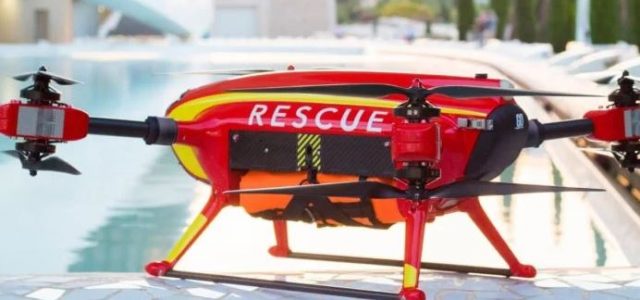As part of the Lifeguard team and now ever present on the beach in the port of Sagunto, Spain, the Auxdron Lifeguard Drone was ready and waiting as one of the Lifeguards sounded the alarm that there were people caught in an undertow and looked like they needed help.
This event happened on Wednesday the 15th of August on a beach known to have strong undertows under certain conditions. The Lifeguard team are well aware of the danger and are trained for these specific situations. One of the most important parts of such a rescue is the response time to the victims. Adrian Plazas and Enrique Fernandez were two Lifeguards who knew this more than most. Together they started a company to design and build a Drone that was capable of saving lives. Three years later their vision was realised when the drone, they developed, saved the life of a woman caught in an undertow that could have cost her life.
Early afternoon on that Wednesday a group of swimmers about 70m from shore realised that they were in an undertow, rapidly being swept out to sea and were unable to return. They managed to signal the Lifeguard in the watchtower and the alarm was sounded. On hearing the alarm the pilot of the Auxdron deployed the drone to the scene.
Communicating with the lifeguard in the tower via radio, the pilot was able to find the distressed swimmers and assess the situation. The pilot Diego Torres told us “Once I heard the alarm I was off, I had a general location but with the help of the lifeguard giving me instructions and the video feed from the drone, we were on top of then within the minute”
The Auxdron has three main functions within a rescue situation. The first is to locate the victims and assess the situation in the least amount of time possible. The drone has the capability, if needed, to deploy two flotation devices that inflate on contact with the water and can be immediately used by the potential victim. Its second function is to clearly identify where the victim is located. By hovering near the victim, the now in transit lifeguards can move towards the location of the drone, knowing that the victim will be nearby. The third function is as a provider of information to the incoming lifeguards as well as the medical team and local police who all have their distinct roles within a rescue. They are all on the same channel and have the same information. The drone can communicate information such as; the number of victims, there perceived condition and their most likely exit point.
As the Drone approached the group the pilot could clearly see that they were in distress. In particular, a lady who was being helped by the other members of the group. The pilot decided to deploy the flotation device. The life vest inflated on contact with the water and because the life vest is attached to the drone, the pilot was able to manoeuvre the life vest directly to the victim. On taking the Life vest, it disconnected from the drone and the victim was able to place it over her head. It was plain to see that she was in a much calmer state once the life vest was placed, she clearly was relieved to know that help was on its way. Moments later two lifeguard on a jet ski was on location and the lady was taken back to shore where the police had already made some space on the beach and medical staff were en route.
The drones work however was not yet done. The pilot remained with the other swimmers in the group who were still in the undertow current and continued to relay information about their condition unit all were safe.
The drone is now an integral part of the Lifeguarding team. This rescue was only possible thanks to the Lifeguard team and the hours of training needed to work together so symbiotically.



















